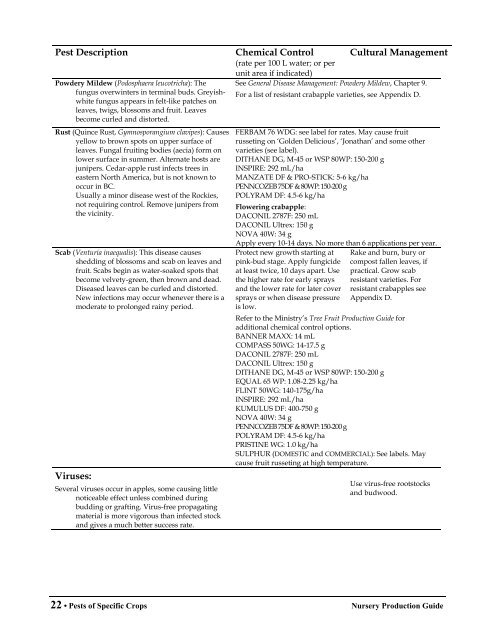Create successful ePaper yourself
Turn your PDF publications into a flip-book with our unique Google optimized e-Paper software.
Pest Description<br />
Powdery Mildew (Podosphaera leucotricha): The<br />
fungus overwinters in terminal buds. Greyishwhite<br />
fungus appears in felt-like patches on<br />
leaves, twigs, blossoms and fruit. Leaves<br />
become curled and distorted.<br />
Rust (Quince Rust, Gymnosporangium clavipes): Causes<br />
yellow to brown spots on upper surface <strong>of</strong><br />
leaves. Fungal fruiting bodies (aecia) form on<br />
lower surface in summer. Alternate hosts are<br />
junipers. Cedar-apple rust infects trees in<br />
eastern North America, but is not known to<br />
occur in BC.<br />
Usually a minor disease west <strong>of</strong> the Rockies,<br />
not requiring control. Remove junipers from<br />
the vicinity.<br />
Scab (Venturia inaequalis): This disease causes<br />
shedding <strong>of</strong> blossoms and scab on leaves and<br />
fruit. Scabs begin as water-soaked spots that<br />
become velvety-green, then brown and dead.<br />
Diseased leaves can be curled and distorted.<br />
New infections may occur whenever there is a<br />
moderate to prolonged rainy period.<br />
Viruses:<br />
Several viruses occur in apples, some causing little<br />
noticeable effect unless combined during<br />
budding or grafting. Virus-free propagating<br />
material is more vigorous than infected stock<br />
and gives a much better success rate.<br />
Chemical Control<br />
(rate per 100 L water; or per<br />
Cultural Management<br />
unit area if indicated)<br />
See General Disease Management: Powdery Mildew, Chapter 9.<br />
For a list <strong>of</strong> resistant crabapple varieties, see Appendix D.<br />
FERBAM 76 WDG: see label for rates. May cause fruit<br />
russeting on ‘Golden Delicious’, ‘Jonathan’ and some other<br />
varieties (see label).<br />
DITHANE DG, M-45 or WSP 80WP: 150-200 g<br />
INSPIRE: 292 mL/ha<br />
MANZATE DF & PRO-STICK: 5-6 kg/ha<br />
PENNCOZEB 75DF & 80WP: 150-200 g<br />
POLYRAM DF: 4.5-6 kg/ha<br />
Flowering crabapple:<br />
DACONIL 2787F: 250 mL<br />
DACONIL Ultrex: 150 g<br />
NOVA 40W: 34 g<br />
Apply every 10-14 days. No more than 6 applications per year.<br />
Protect new growth starting at<br />
pink-bud stage. Apply fungicide<br />
at least twice, 10 days apart. Use<br />
the higher rate for early sprays<br />
and the lower rate for later cover<br />
sprays or when disease pressure<br />
is low.<br />
Rake and burn, bury or<br />
compost fallen leaves, if<br />
practical. Grow scab<br />
resistant varieties. For<br />
resistant crabapples see<br />
Appendix D.<br />
Refer to the Ministry’s Tree Fruit Production Guide for<br />
additional chemical control options.<br />
BANNER MAXX: 14 mL<br />
COMPASS 50WG: 14-17.5 g<br />
DACONIL 2787F: 250 mL<br />
DACONIL Ultrex: 150 g<br />
DITHANE DG, M-45 or WSP 80WP: 150-200 g<br />
EQUAL 65 WP: 1.08-2.25 kg/ha<br />
FLINT 50WG: 140-175g/ha<br />
INSPIRE: 292 mL/ha<br />
KUMULUS DF: 400-750 g<br />
NOVA 40W: 34 g<br />
PENNCOZEB 75DF & 80WP: 150-200 g<br />
POLYRAM DF: 4.5-6 kg/ha<br />
PRISTINE WG: 1.0 kg/ha<br />
SULPHUR (DOMESTIC and COMMERCIAL): See labels. May<br />
cause fruit russeting at high temperature.<br />
Use virus-free rootstocks<br />
and budwood.<br />
22 • <strong>Pests</strong> <strong>of</strong> <strong>Specific</strong> <strong>Crops</strong> Nursery Production Guide
















